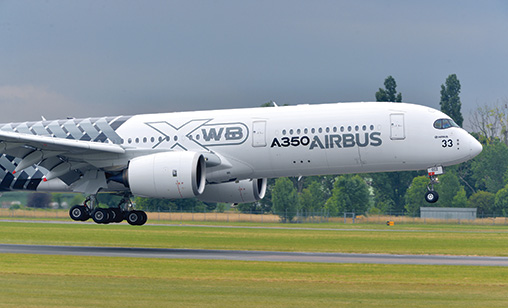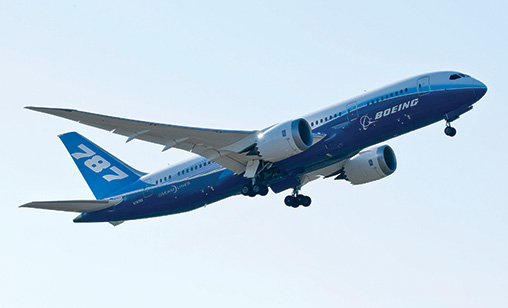Environment
Landmark industry standards for emissions
Airlines and industry manufacturers universally supported the long-awaited announcement on emission standards for passenger and cargo jets but some critics want more stringent rules.
March 1st 2016
It has taken six years of painstaking negotiations and technical work, but finally the world’s aviation regulator, in the form of the International Civil Aviation Organisation’s (ICAO) environment panel, has announced new standards for greenhouse gas emissions from aircraft. Read More »
From 2020, ICAO will require all new aircraft designs to meet the new standards. Designs already in production must comply after 2023. There will be a cut off date of 2028 for manufacturers that have not introduced the new ICAO standards into their aircraft fleets.
 |
| ICAO council president, Olumuyiwa Benard Aliu: the next generation of aircraft types will have guaranteed reductions in carbon emissions |
The standards will be the first to impose binding energy efficiency and carbon dioxide (CO2) reduction targets for aviation. When fully implemented, they are expected to reduce carbon emissions from aircraft by more than 650 million tons between 2020 and 2040, equivalent to removing more than 140 million cars from the road for a year.
Airliners must achieve an average 4% reduction in fuel consumption during the cruise phase of flight, starting in 2028, when compared with planes delivered in 2015. They also must set a 33% emissions reduction target for new large aircraft in production, commencing in 2023 and staggered over a five-year period.
Negotiators agreed to a second standard, which would deliver a 36% reduction in emissions on new models of large planes from 2020. The new standards will not apply to existing in-service aircraft.
The Committee on Aviation Environmental Protection (CAEP)’s agreement must be approved by ICAO’s 36-nation governing council, but no substantial changes are expected. ICAO council president, Olumuyiwa Benard Aliu, said the agency’s goal “is ultimately to ensure that when the next generation of aircraft types enters service, there will be guaranteed reductions in international carbon emissions”.
“The agreement of this CO2 standard is a vital and very welcome development,” said Tony Tyler, director general and CEO of the International Air Transport Association (IATA). “The CO2 Standard does not solve aviation’s climate challenge on its own, but it is an important element in our comprehensive strategy for tackling carbon emissions.
“The next milestone will be the implementation of a Market Based Measure to address CO2 emissions, which we hope will be agreed at the ICAO Assembly in September. Our shared industry goals are for carbon neutral growth from 2020 and a 50% cut in CO2 emissions by 2050. This CO2 standard is a significant milestone in meeting those targets. It proves the industry and the world’s governments are working together in seeking a sustainable future for aviation.”
The announcement was welcomed by the big aircraft manufacturers. “Airbus has invested significantly in improving the environmental performance of its sites, products and services, consistently bringing the most eco-efficient aircraft to the market, meeting and surpassing environmental performance requirements,” the Toulouse-based plane maker said in a statement.
It said its new A320neo reduces CO2 emissions by 15% today, rising to 20% by 2020, while the A350 XWB is cutting CO2 emissions by 25% compared with the aircraft it is replacing. The A330neo will offer a 14% reduction in CO2 emissions, and the A380, in service since 2007, shows a 40% reduction in CO2 emissions compared with previous generation very large aircraft.
 |
 |
Boeing commended the CAEP agreement and said it is fully committed to meeting the new emissions standards. This agreement represents real progress beyond the substantial industry achievements already made to reduce aviation emissions, it said.
“The new standard is ambitious and will become part of the certification process applied to every airplane before delivery based on the ICAO schedule,” it said in a statement. “We have made significant investments to improve the efficiency and environmental performance of our products and will continue to do so. Environmental goals are aligned with our business goals as greater fuel efficiency and lower emissions are top priorities for our commercial customers.
"We believe the ICAO standard will have the intended results of ensuring older aircraft are replaced by newer, more efficient aircraft that will further reduce fuel use and carbon emissions.”
Boeing said its B787 Dreamliner family reduces fuel use and CO2 emissions by 20% to 25% compared with aircraft it replaces.
The new B737 MAX, with first delivery expected in 2017, will reduce fuel use and emissions by 20% compared with the original Next-Generation B737. The B777X, with first delivery scheduled for 2020, will be the world’s largest and most fuel-efficient twin-engine jet, said Boeing.
Even the White House chimed in with praise, when it said the agreement “is an important signal that the international community is well-positioned to rise to the challenge of implementing a global market-based approach to reduce aviation emissions”.
But the response from some environment groups was muted. Dan Rutherford, aviation director at the U.S.-based International Council on Clean Transportation, said the standards don’t set the bar high enough. He said they require reductions of only a third of what aircraft will be capable of achieving when the ICAO standards take effect.
As a result of demands from their airline customers, the latest Boeing and Airbus designs already meet the proposed efficiency standards, he said. In the meantime, the manufacturers can continue to sell older, less efficient designs for years as airliners now in use are exempt from the new standards altogether, meaning even dirtier planes can continue to fly, he said.
Environment groups added ICAO had been working on international standards for 18 years and is now proposing to give aircraft manufacturers another dozen years to comply.
“This outcome was the minimum needed from ICAO for a credible first start,” said Bill Hemmings, aviation director at Brussels-based NGO, Transport & Environment. “The Europeans moved a bit, but it was not what the U.S. administration wanted.”